IsshoNihongo! is a walkthrough of Japanese grammar and sentence structure. Follow me as I explain Japanese from the ground up. 🇺🇸🇯🇲🇭🇳
Don't wanna be here? Send us removal request.
Text
Kun’yomi
Once you understand the concept of Kanji on’yomi, then you can move on to the idea of kun’yomi. In this post, let’s get into the details of this other way to read kanji characters.
What Are Kun’yomi?
While on’yomi are the Chinese-based readings of Kanji, kun’yomi are the Japanese way to read them. Kun’yomi is written in Kanji as 訓読み, which can be translated as “meaning readings”.
When Kanji were imported into the Japanese language, there was already a… well… Japanese language. It just was a largely spoken language. The influx of all these new characters gave Japanese speakers a great opportunity to use them to express already-existent concepts and words in written form. This is the reason why most Kanji have both on’yomi and kun’yomi.
When Will You See / Hear Kun’yomi?
Let’s look at our words with the Kanji “男” again. One of its on’yomi is だん but its kun’yomi is おとこ. When do you see the おとこ reading used?
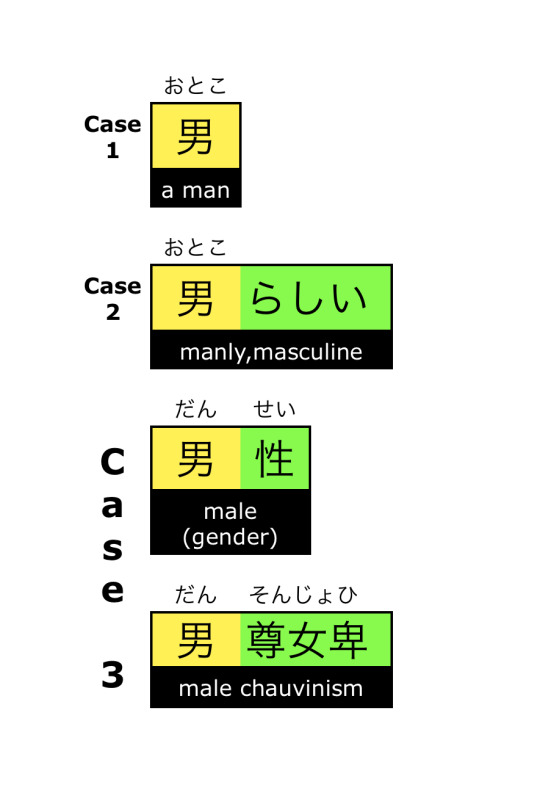
In general, kun’yomi are used when Kanji appear by themselves (case 1), or if there is okurigana present (case 2). We’ll get into exceptions in a bit, but this is a loose tendency that will help you more times than not.
Kanji Readings in the Dictionary
If you look up the kun’yomi of a Kanji character in the dictionary, you might find it written in 1 of 3 different ways. Because kun’yomi are the Japanese way of reading Kanji, they most often include okurigana. The three different ways to show kun’yomi revolve around the way that okurigana will be written.
Here is an example of what you will see if you look up the Kanji “空” on a great website called Kakimashou:
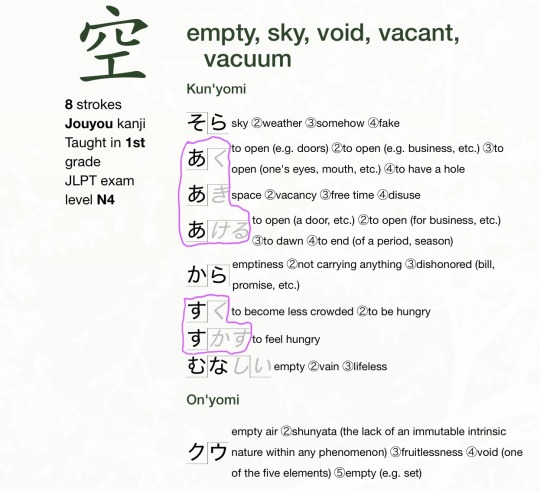
Even though 8 words that use kun’yomi are listed, if you get rid of overlap, there are only 5 unique readings.
Another way of listing kun’yomi is by using parentheses. Here is the entry for 空 on Renshuu:

Notice though, that the readings appear jumbled. There is a reading of そら, followed by two readings of あ, followed by a reading of から, followed by あ again. This is because the readings are grouped by when Japanese students learn them! The small Kanji 小 tells us that students learn 4 kun’yomi in elementary school. The other 4 kun’yomi that are marked with an ✖️ are not learned in school.
Finally, there is the method that I use - dots. In Japanese, the punctuation mark that looks like a dot and has spaces on either side (・) is called なかぐろ or なかてん. The following screenshot is from a website called Tae Kim’s Guide to Learning Japanese.
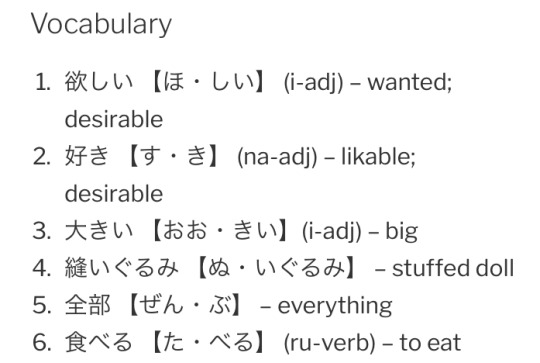
Tae Kim uses なかぐろ to separate the Kanji portion of a word from the okurigana. In Kanji compounds (like 全部) the なかぐろ separates each Kanji character’s reading.
Out of the 3 styles, I prefer using either なかぐろ or parentheses because sometimes the difference in color may not be so easy to see. At the end of the day it simply comes down to preference. The most important thing is that you understand what you are seeing when you visit and use these different sites to help you with your Kanji learning.
Hybrid Words
So our very loose tendency for figuring out a Kanji reading is as follows:
If the Kanji is by itself, or has okurigana - use kun’yomi If the Kanji is part of a compound- use on’yomi
Ok, easy enough. Unfortunately though, there are (as always) exceptions. Some words are actually a mix of both types of readings!
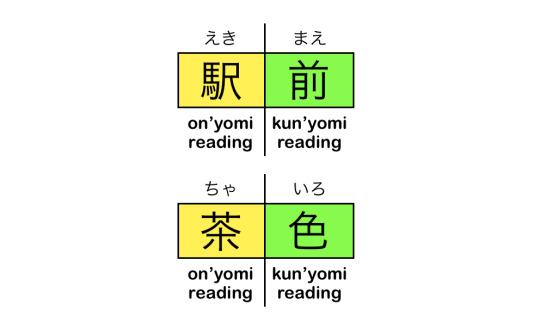
駅前 (meaning “in front of a train station”) and 茶色 (meaning “brown”) are examples of words where the first kanji is read with on’yomi while the second one is read with kun’yomi. These types of words are called じゅうばこよみ (重箱読み).*
The reverse is when the first Kanji is read with kun’yomi while the second is read with on’yomi. These types of words are called ゆとうよみ (湯桶読み).*
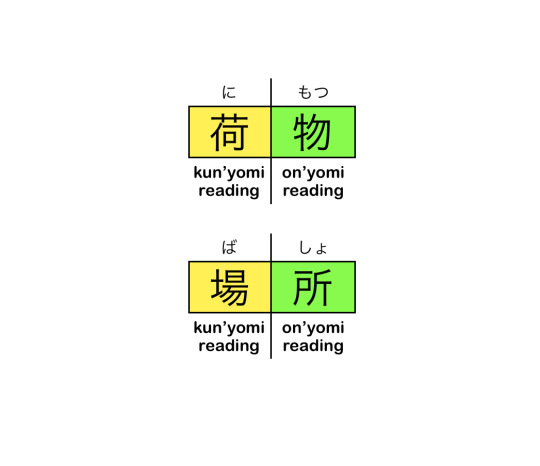
荷物 means “luggage, baggage, or stuff” and 場所 means “place, or location”.
It’s very easy to find lists of じゅうばこよみ and ゆとうよみ words online if you google them. No one is going to ask or quiz you on this information, but it may explain why some Kanji compounds are read in a way that might surprise you.
Shared Kun’yomi (Homophones)
Because Japanese has so many words and yet so few sounds, sometimes the issue of different Kanji with the same kun’yomi will come up. Let me show you when this matters and when this doesn’t matter.
An example of when this won’t bother you is with the Kanji 上 and 空. Both of these Kanji have kun’yomi of あ and can be used to write verbs. However, 上 can be the あ in あげる and あがる while 空 can be the あ in あく and あける. Even though the 2 Kanji have a common kun’yomi, the okurigana forces you to use certain Kanji. It will help you to differentiate when you should / can use 上 and when you should / can use 空.
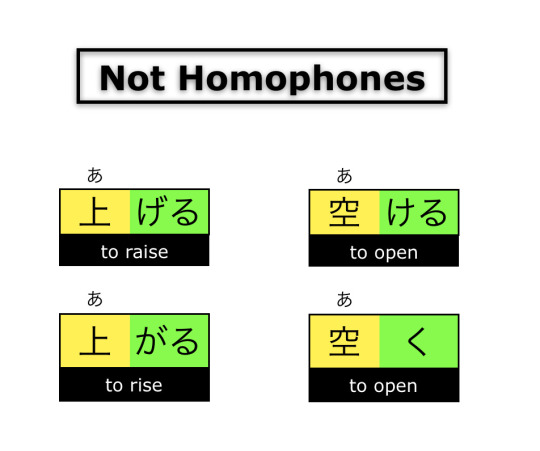
On the other hand, take 早 and 速. Both of these Kanji have kun’yomi of はや. They both also can take okurigana い. Therefore if you want to write / text the word はやい, which Kanji should you use??
Of course, the good news is that those 2 homophones have different meanings. 早い means “early” as in the opposite of “late” while 速い means “fast” as in the opposite of “slow”. These meanings are different enough that they shouldn’t cause problems.
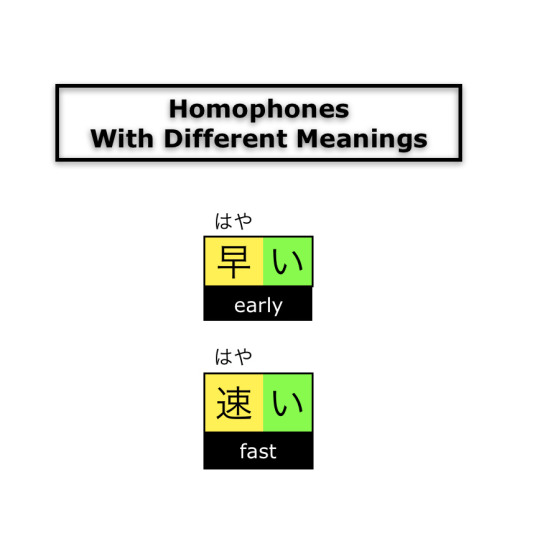
What becomes difficult is when you have homophones that are similar in meaning to us non-native speakers! For example the words 書く and 描く are both pronounced かく. かく written with the Kanji 書 means “to write” as in letters, characters, words and symbols. On the other hand, かく written with 描 means “to draw pictures or charts”.
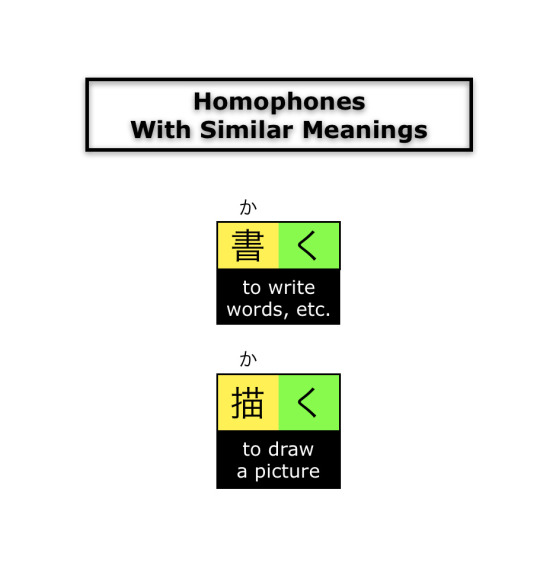
Another example dear to my heart is 飲む and 呑む, both read as のむ.**
For these kinds of cases, there will usually be a “default way” which won’t cause much confusion. If you use 書く instead of 描く it won’t really be a problem. Also, there won’t be any problem when it comes to spoken conversations.
Total Number of Kun’yomi
When it comes to the total number of kun’yomi, it turns out to be a little more complicated than the total number of on’yomi. With kun’yomi, you have to take into account the fact that some Kanji will take okurigana while others won’t. This leads to a lot of unique kun’yomi.
Out of the 2,136 everyday-use Kanji, there are only 59 on’yomi with 1 Kanji. (For example, the only Kanji with an on’yomi of タツ(たつ) is 達.) Conversely, there are a whopping 640 kun’yomi with 1 kun’yomi! (For example, the word あじ can only be written with the Kanji 味.) It actually doesn’t make sense to think about how many kun’yomi there are in all.
On the other hand, it is helpful to know how many Kanji have only 1 kun’yomi. Those numbers are:
Elementary School Kanji: 13 All Jōyō Kanji: 69
What’s even better is that out of those 13 characters, 8 are mostly only used for prefecture names!
Grades 1 - 6: 貝、皿、箱、届、株 Place Names: 埼、岡、崎、栃、梨、潟、熊、茨
You can copy and paste the above lists into your dictionary or into a site like Kanshudo to get detailed information on each character.
Conclusion
There you have it! Now you are well-versed in the 2 main ways to read Kanji characters!
There is a third and final way to read Kanji, which is called なのり. I won’t be writing a post about that, but it is the way that Japanese people use Kanji to write their names and the names of places. You will find yourself getting used to なのりby looking at train station, city, prefecture, and even river names. Because you have a limited amount of “study energy” to allocate, I’d recommend learning those readings passively.
Enjoy your studies, and see you next post!
Rice & Peace,
– AL (アル)
👋🏾
* Interestingly, the word じゅうばこ itself is an on’yomi-kun’yomi compound, and ゆとう itself is a kun’yomi-on’yomi compound. They are both autological words.
** 飲む means “to drink” and can be used for any beverage but 呑む means “to drink a lot of alcohol”. 😉
#japanese#日本語#japanese language#japanese studyblr#learn japanese#日本語の勉強#language studyblr#にほんご#language#study kanji#learn kanji#japanese kanji#kanji#isshonihongo
13 notes
·
View notes
Text
On’yomi
When you see an individual word written in Hiragana or Katakana, there is no question as to how you read that word. Hiragana and Katakana are very regular and consistent in their pronunciations. Kanji, on the other hand, are an entirely different story. In this post, let’s get into one of the ways that you can read Kanji characters. Let’s get into the world of on’yomi!
What Are On’yomi?
In general, Kanji characters can be read in 3 ways*. 1 way is based on the characters’ original Chinese readings and is called on’yomi. In Kanji, on’yomi is written as 音読み, and means ”sound reading(s)”. At certain times during the history of Japan, many words and ideas entered into the language but had no Japanese equivalents. Therefore, the words were pronounced very closely to their Chinese pronunciations. These are the on’yomi.
Sidebar: Because on’yomi means “sound reading(s)”, it is redundant to say “on’yomi reading”. (It’s the same way that ATM machine is actually ridiculous because the “M” already stands for machine lol)
When Will You See / Hear On’yomi?
Take a look at the following 4 words that I used in the last post:
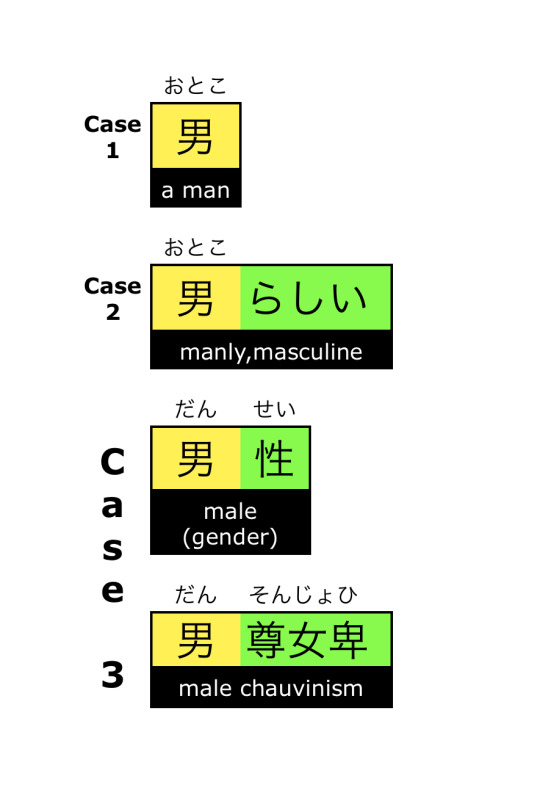
They all contain the Kanji 男, which has an on’yomi だん. What do you notice about the words that have だん in them?
Words that are made up of 2 or more Kanji are called compounds (called jukugo [熟語] in Japanese). Kanji compounds are in contrast with single Kanji (case 1) and Kanji with okurigana (case 2). Most times, kanji compounds will use on’yomi.
Of course, there are exceptions. Take a look at the following 2 compounds:
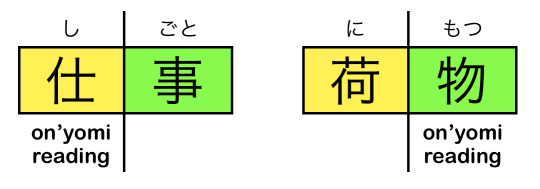
Both 仕事 and 荷物 are considered “hybrid” words. We’ll talk more about these kinds of compounds in the next post.
Multiple On’yomi
Because Kanji came into Japanese at different times, often a single character might have 2 or more different readings. Let’s look at the Kanji 行:
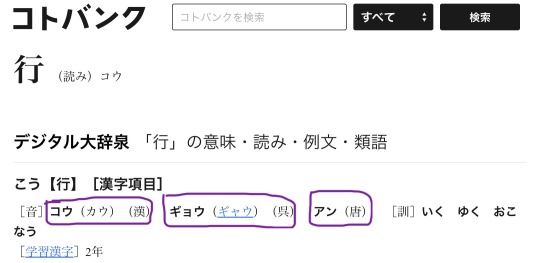
I circled the 3 different on’yomi this character has. Because on’yomi originally came from Chinese, Japanese dictionaries mostly use Katakana when listing them.
So here is the (likely) story of the character 行:
When it first made its way into Japanese, it was read as ぎょう. But then anywhere from 100 to 300 years later, another wave of Kanji were imported into Japanese. While recording the new characters, the Japanese people noticed that 行 was now being read as こう!(I’m guessing) They said, “Alright then… we’ll update our records.” Then came the final wave of Kanji many decades later. At that time, they looked at the character again and noticed that it was being read as あん! That, my friends, is how 行 has 3 different on’yomi.
It’s safe to say that the あん reading is the least used. The few times you might find it used, it will be in religious or spiritual words like 行脚 (あんぎゃ)**, which means “a pilgrimage”.
Many Kanji have this kind of history where the character ended up being updated with additional readings over the course of hundreds of years. It certainly is interesting to read and think about.
Studying Kanji and On’yomi
At this point, you might be wondering, “How in the world can I memorize thousands of Kanji, each with multiple on’yomi!?”
The answer is ゆっくり-LY! (ゆっくり means taking your time.)
I think it’s important NOT to cram and/or rush your Kanji (and Japanese) study. In my opinion, thoroughly studying 3-5 kanji a day and learning vocabulary that contain them is better than rushing through 10 to 15 characters a day.
Also, the history of how Kanji acquired their on’yomi is not only interesting, but also a good guide for your own study. Most Kanji came into a japanese with only 1 Chinese reading. Many many years later, additional readings were added. In the same way, I recommend starting your studies with 1 main on’yomi for each character. Once you make a strong mental connection between an individual character and its main on’yomi, meaning, and nuance, then you can slowly add other meanings and readings to your ”mental Kanji rolodex”. Doing too much too fast is going to burn you out, and lead to you forgetting a lot of information!
How Many Are There?
Before I get to that, you should know how Japanese students generally study Kanji. They learn and thoroughly study the characters for 12 years. In the first 6 years (elementary school) they learn 1,026 characters. Then, throughout junior high and high school, they learn another 1,110 characters. In all, these 2,136 characters are called Jōyō Kanji, which means “daily use Kanji”.
Now, even though there are thousands of kanji, the good news is that there only a few hundred possible on’yomi for those Kanji. I crunched the numbers and data and came up with the following:
Grades 1 - 6 : 270 readings All Jōyō Kanji : 306 readings
This means that all the Kanji that a Japanese student learns by the 6th grade can be grouped into 270 possible on’yomi sounds. By the time they graduate high school, that number goes up, but only to 306.
To me, those numbers are a lot more manageable than 2,136!
Here is a chart I made with all the possible on’yomi for elementary school Kanji:
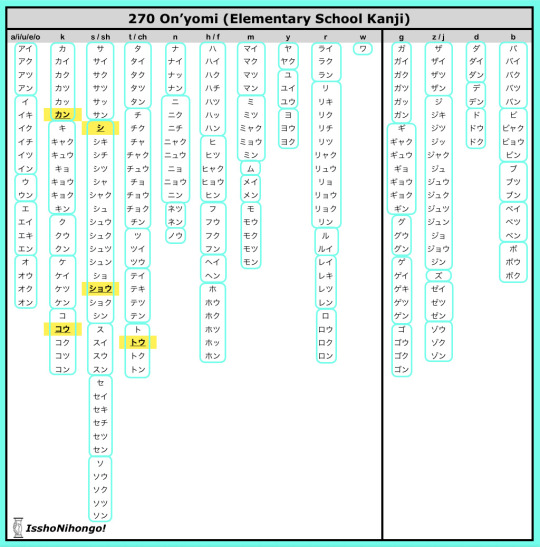
The top 5 common readings are:
シ (し) コウ (こう) ショウ (しょう) セイ (せい) キ (き)
Kanji With Only 1 On’yomi
Most Kanji characters will have one or more on’yomi. (There are even a good number that actually don’t have ANY!) Of the Kanji that elementary school children learn, about 23% of them have only 1 on’yomi!*** I’ll list them here for reference:
Grade 1:
校、王、百
Grade 2:
科、活、汽、午、才、算、週、線、点、電、肉、番、毎、曜、理
Grade 3:
医、意、員、院、駅、央、界、階、感、漢、級、局、銀、区、具、県、号、詩、式、昭、章、族、第、題、談、帳、鉄、農、倍、秒、部、服、福、勉、予、洋、陽、両、列
Grade 4:
愛、案、以、胃、英、億、貨、課、械、害、完、官、観、希、季、紀、議、給、協、訓、軍、郡、径、景、芸、航、康、材、昨、察、士、史、司、順、賞、信、席、卒、隊、単、貯、腸、停、典、徒、堂、特、毒、念、票、標、府、副、未、脈、約、陸、料、令、歴、労、録
Grade 5:
圧、衛、液、演、往、恩、可、賀、刊、規、義、旧、均、禁、句、件、券、検、個、護、鉱、講、査、賛、師、資、識、舎、術、準、序、証、条、状、職、制、製、税、績、��、総、像、則、属、態、適、銅、徳、能、版、非、評、婦、復、複、弁、貿、輸、容、略、領
Grade 6:
域、宇、拡、閣、看、簡、揮、系、警、劇、憲、后、��、穀、策、視、詞、誌、磁、尺、樹、純、処、署、諸、将、寸、聖、宣、層、臓、宅、誕、段、宙、忠、庁、賃、展、党、糖、脳、派、肺、俳、班、晩、批、陛、棒、枚、密、盟、郵、翌、覧、論
I left out the Kanji that are primarily used for Prefecture names.
I can tell you that there is absolutely NO shortage of Kanji study plans on the internet! (Back in the day I used Wanikani, but Renshuu is REALLY good as well.) Everyone has a suggested order for how they think you should learn Kanji. My goal here is to just be a resource for those of you who may not know where to start. Choosing Kanji that have only one main on’yomi may be a good starting goal that can lead you to other reachable goals.
Just take it one character at a time! 👍🏾💪🏾
On’yomi Decoding
As you learn more and more Kanji and your vocabulary grows, you will notice yourself doing something very interesting. You will start to do something similar to what is called ”decoding”. Native English speakers learn decoding skills in kindergarten and elementary school when they break down spoken words into individual sounds (phonemes). At some point, you will start to break down Japanese words you hear into parts that you know, and parts that you don’t know. For Kanji compounds, these parts are on’yomi.
Let’s take a very common word - りょこう. If we think about the possible ways to break this word down by sounds, we get:
りょ—こ—う or りょ—こう or りょこ—う
As it turns out, りょこ is not a valid on’yomi so the third choice is out. Using a dictionary, you’ll find that the word is made up of りょ (旅) and こう (行). The word means “a trip” or “travel”.
This skill of decoding will be very helpful as you improve your Japanese - especially when you hear new words in the middle of your conversations.
Learning Kanji Using Japanese
Lastly, I have 2 very useful questions that you can use to help you improve your Japanese and strengthen your knowledge of Kanji.
Let’s say that you have the word りょこう mastered; you know the meaning, and that it’s written in Kanji as 旅行. Let’s also say that during a conversation one day, you hear the word せいこう for the first time. You are curious if the こう in this word is the same こう in 旅行. How can you ask a Japanese speaker this question?? Here’s the framework:
① 【word you just heard】 の 【on’yomi】 は、【word you know】 の 【on’yomi】 ?
I should first say that the は in this question is actually pronounced as “wa”. So in this situation, the question you would ask is:
「せいこう」 の 「こう」 は、「りょこう」 の 「こう」?
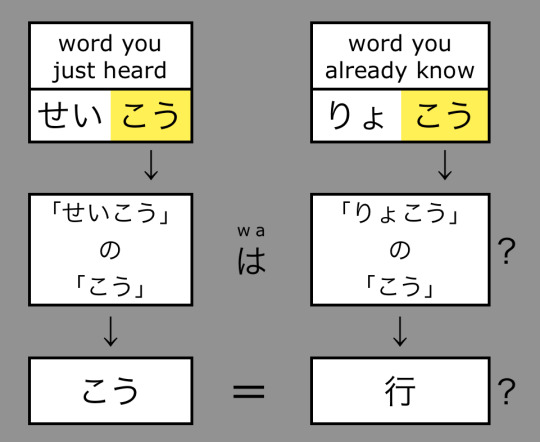
DRUMROLLLLL…
Unfortunately the answer is a big fat NO. せいこう is written in Kanji as 成功 and means “achievement” or “success”. But, don’t worry. By simply using that question, you are practicing asking a question in Japanese, and you will also be impressing native Japanese speakers because you are showing effort towards learning Kanji. In some cases, you may even stump native speakers because they may have forgotten exactly which Kanji goes with the word you are asking about!
If you are feeling extra brave, you can ask the open-ended version of the question:
② 【word you just heard】 の 【on’yomi】 は、なに? ⬇️ 「せいこう」 の 「こう」 は、なに?
In that question, the word なに translates to “what”. You are therefore asking “what (Kanji) is the こう in せいこう?” Both questions ① and ② are ones that I use often in my everyday life.
Conclusion
Well there you have it! I think that you will come away from this post knowing much more about how you can read Kanji compound words. In the next post, we’ll talk about the other main way that Kanji characters are read. Stay tuned, and good luck studying those Kanji!
Rice & Peace,
– AL (アル)
👋🏾
* Technically, there are 3 kinds of readings: on’yomi, kun’yomi, and nanori (written as 名乗り), which are readings for people’s and place names.
** The ぎゃ reading for the 脚 Kanji is also fairly rare.
*** These kanji may be listed as having other readings, but you’ll find that for each character, only 1 on’yomi is used almost all of the time.
#japanese language#日本語の勉強#japanese studyblr#japanese#日本語#learn japanese#language studyblr#にほんご#study kanji#learn kanji#kanji#japanese langblr#japanese kanji#isshonihongo
45 notes
·
View notes
Text
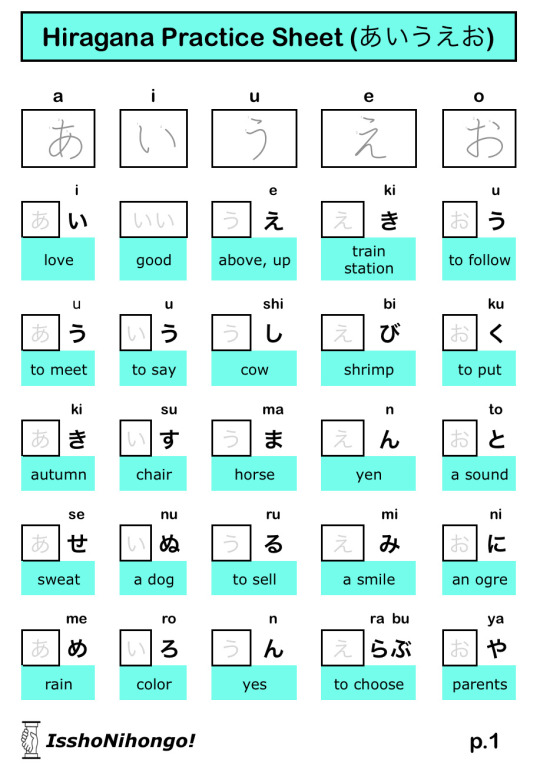
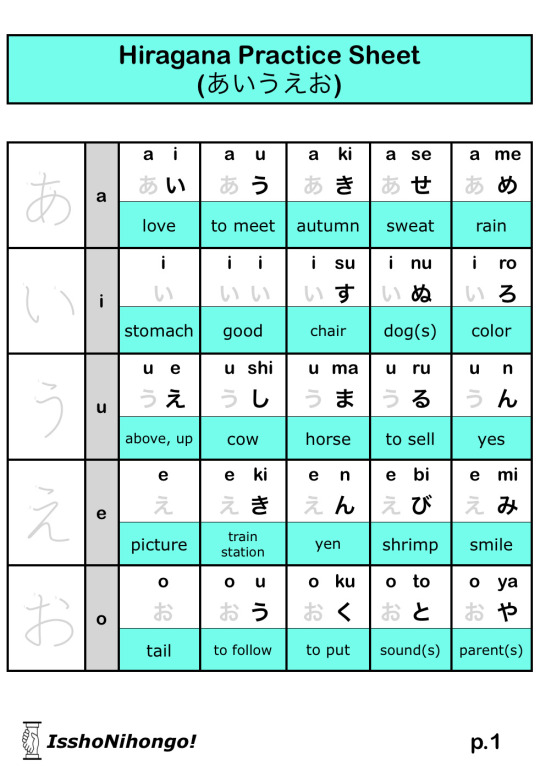
#japanese#日本語#japanese language#japanese studyblr#日本語の勉強#language studyblr#にほんご#learn japanese#learn hiragana#hiragana#isshonihongo
8 notes
·
View notes
Text
An Introduction to Kanji
Whether you are about to study your first Kanji character, or you have been studying for a while - welcome! In this first post of the Isshonihongo! Kanji section, I want to do a quick and simple overview of Kanji. In future posts we can deep-dive into the nitty-gritty of it all.
With that, let’s get into it!
A Super Brief History
Kanji characters originally came from China. How and who introduced them into Japanese is up for contention, but most likely it was through the nearby Korean peninsula. The thing is, it’s not like Japanese people were using ESP to communicate with each other. They had their own language that they were speaking. What makes things even more complicated is that Kanji didn’t get imported all at once; it happened slowly and over 3 different time periods. We’ll get into how that has affected the readings of the characters later in the on’yomi and kun’yomi posts. However, it’s safe to say that you can understand why Kanji is such a beautiful mess 😂
The Letter “A”
I want you to think of the English letter “a”. (I’m partial to it because it’s the first letter in my first and last name, but that’s neither here nor there.) It is one letter in, and thus one of the 3 sounds of the word “cat”. However, it can be a word all by itself too. Ok, keep that in mind.
When it comes to pronouncing the letter “a”, there are also different ways to go about it. The “a” in “cat” is not pronounced the same way as the one in “mate”. Furthermore, the pronunciation of the “a” in “car” is affected by the “r” that comes after it.
By now I think you see where I’m going. Our character “a” has A LOT in common with Kanji! (Coincidentally, the same is true with “I” / “i”.)
How Kanji Work
So how exactly Do Kanji work?? I’m glad you asked!
Kanji are logograms. This means that they are symbols that represent words or parts of words. This is in contrast to phonograms (the English alphabet has these*), which represent sounds.
Each Kanji also represents an idea or a concept. Let’s take the character 男 for example. It represents the idea of “man”. By itself, this Kanji is a word. We can alternatively combine 男 with okurigana to make different words. Our final choice is to combine 男 with 1 or more other Kanji to make other words. Take a look at the 3 different cases:

Now, not all Kanji can form words by themselves like case 1. Many characters only make sense if they are with other characters, or with okurigana. The main thing to remember is that in any case, Kanji characters carry their ideas or concepts with them when they form words.
We are lucky if we have a Kanji like 男 because it only has one idea associated with it. Every time you see 男 it is contributing the concept of “man”. A Kanji like 高 carries the idea of “tall” as well as “expensive”. Thankfully, context will mostly make it clear which idea is being expressed.
Reading Kanji
I love word puzzles! I especially enjoy cryptograms. Here is an example:

In the cryptogram above, each number represents a letter. Every time you see that number, you’ll see the same letter above it. Unfortunately… Kanji don’t work this way.
Most Kanji have at least 2 ways that they can be read - with on’yomi readings and with kun’yomi readings. Which reading you need to use will depend on the Kanji and the surrounding characters. In the 4 words with 男 you can see that sometimes it is read as だん and other times as おとこ. This is a consequence of mixing Chinese characters with pre-existing Japanese words and ideas.
How Native Speakers Learn Them
Elementary school students learn a set number of Kanji each year from 1st to 6th grade.
1st - 80 characters 2nd - 160 characters 3rd - 200 characters 4th - 202 characters 5th - 193 characters 6th - 191 characters
They do writing and reading drills almost everyday! The thing that I love about Kanji is that the amount of words you can use increases exponentially with the more characters you learn. With 80 characters alone, you wouldn’t believe how many words 1st graders can make and write!
By no means am I saying that you have to learn Kanji in the same way and order that they do. (After all, they are hearing Japanese words all day, everyday. Plus, they are getting gently corrected at home and at school.) However, if done right, learning even 3 to 5 characters a day will increase your vocabulary by an incredible amount!
Why Kanji Are Important
Technically, you COULD learn Japanese words by sound only and stick to Hiragana and Katakana. But if you plan on texting with Japanese friends or reading anything not aimed for elementary kids, then you’re going to be up Schitt’s Creek. 😉
Take a look at this paragraph about karaoke:

I can read that, but it’s annoying actively looking for / thinking about the end of one word and the beginning of the next. A mix of Kanji, Hiragana, Katakana and numbers actually make paragraphs EASIER to read. This is just 1 reason Kanji are helpful.
Kanji may seem daunting at first, but learning vocabulary actually helps you learn Kanji better. I recommend thinking about each character as a flashcard. On the front you have the character, and on the back you have keywords, nuance, and its readings.

Nuance is very important because sometimes 2 Kanji may have the same or similar keywords but differ slightly. For example, the following 2 characters may be / are easily confused by beginners:
温 keyword: warm
暖 keyword: warm
Both of them carry the idea of “warmth” but the nuance is different. 温 is warmth that you feel when you touch / hold something while 暖 is ambient warmth. Think of the temperature in a room, or outside in the spring. When you learn a character, knowing information like this will prevent confusion down the line.
Conclusion
There you have it! I hope that reading this post has given you a glimpse into the vast world of Kanji. Yes, there will be difficult times in the Japanese road ahead but believe me, it’s worth it. I’m so glad that I jumped into the “Kanji pool” early on. It has helped me understand certain words and concepts, as well as the culture much better. I hope you have a similar experience! Good luck!
Rice & Peace,
– AL (アル)
👋🏾
*English has several logograms too! An English-speaker knows what the following symbols represent without needing any words:
&, $, ¢, @, °, #, £, and €
#isshonihongo#日本語#study kanji#learn kanji#japanese kanji#kanji#漢字#language blr#study blr#language studyblr#language#language stuff#japanese language#language study#にほんご#日本語の勉強#日本語勉強#japanese langblr#studyblr#study japanese
27 notes
·
View notes
Text
IsshoNihongo! Kanji Page
Hello everyone! 👋🏾 If you are studying Kanji then this is the page for you!
A lot of Japanese learners are very enthusiastic while they are learning Hiragana. But there is often a fear of Kanji. Some people say that they are overwhelming and intimidating. Others might think that they are mysterious and cool. No matter what you may think, it’s a fact that Kanji are a vital part of the Japanese language. This is a deep-dive into these beautiful meaning-filled characters. Enjoy!
① Introduction to Kanji
Reading Kanji
② On’yomi ③ Kun’yomi ④ Kanji Phonetic Parts
Listening Skills
⑤ Sound Changes - Part 1 (そくおんびん) ⑥ Sound Changes - Part 2 (れんだく) ⑦ Kanji Prefixes & Suffixes
Drawing Kanji
⑧ Kanji Semantic Parts ⑨ Stroke Order
#japanese#日本語#japanese studyblr#japanese language#learn japanese#日本語の勉強#language studyblr#にほんご#study kanji#kanji radicals#learn kanji#kanji#isshonihongo#japanese kanji#studying japanese#japanese study#studyblr#language blr#study blr#japanese lesson#learning japanese
18 notes
·
View notes
Text
Furigana & Okurigana
As you progress with your Japanese studies, you will see two very important kinds of Hiragana. They are called furigana and okurigana. In this post let’s take a look at each of them and how they both help Japanese learners and natives read Kanji!
But first, let me introduce a chart for the vocabulary that you’ll see in this post. Each word is written in Kanji and then in Hiragana, with its part of speech and meaning.

1) Furigana
Furigana, also known as よみがな or ruby, are the Hiragana characters either on top or to the side of Kanji characters.

As you can see, if the writing is horizontal, the furigana will be on top and if the writing is vertical, it will be on the right side. Either way, furigana tell you how to pronounce the Kanji characters.
There may be anywhere from 1 to 5 Hiragana characters represented by a single Kanji character!

We Japanese learners need furigana when we start studying Kanji and reading Japanese text. But Japanese children also need furigana when they are learning Kanji and even Katakana. Here you can see furigana used to learn Katakana characters.
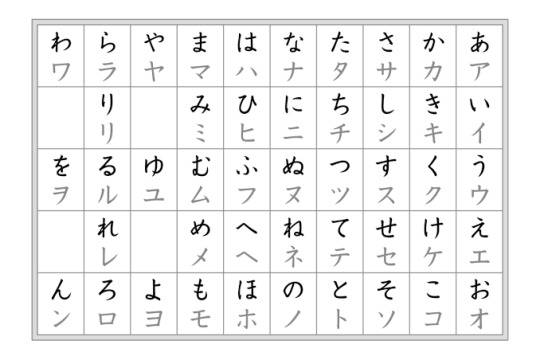
Whether or not you see furigana depends on a few different factors:
the intended readers
the rarity of the Kanji
Generally, you won’t see many examples of furigana. However, if you pick up a book/novel intended for elementary-aged children, you might see lots of furigana. This is because (like us!) they either haven’t learned the Kanji’s readings or the writer intended the Kanji to be read in a certain way.
Some websites, books, IG posts, Youtube videos, etc that are intended for non-Japanese readers will also have a fair amount of furigana. Granted, it is helpful at first, but it’s a good idea to wane yourself off of furigana as you get better (or if you WANT to get better). The more you see a Kanji character, the more likely you are to remember its reading.
Gikun
Sometimes furigana doesn’t actually tell you the reading of the Kanji. Instead it’s used to add details or add shades of nuance, as in the examples below:

In these cases we call the furigana gikun, which loosely translates to “a false reading”.
On the left, the Kanji reads きぼう, which means “desire or wish” but the furigana reads ひかり, which means “light”. This conveys to the reader that light is a metaphor for hope in whatever setting you are seeing that Kanji.
On the right, the Kanji reads ちきゅう, which means “Earth” but the furigana reads ふるさと which means “home town” or “where someone is from”. This tells the reader that someone is an Earthling – as compared to a Martian or an alien from another planet.
This is a more-advanced way that furigana is used, so you won’t see it unless you are reading manga or novels aimed for native speakers.
First the Word, Then the Kanji (Ateji & Jukujikun)
On the day that I arrived in Japan, they asked me for my name in Katakana at the airport. I hadn’t really thought about it so they wrote my name how it sounds to the Japanese ear.
A few days later, I was thinking about this, and it occurred to me that in the same way that they just “assigned me” katakana, I could also give myself Kanji for my name! My name is Albert but I took my nickname Al and “Hiraganized” it, getting ある. At this point I needed 1 or 2 Kanji that sounded out ある. I eventually decided on 亜琉. I’ll come back to this a bit later.
亜琉 is what is called ateji. I started with a word and “worked backwards” to end up with Kanji, based on their readings. Another example of ateji is the Japanese word for The United States. Written with Hiragana it’s あめりか, but written with Kanji it becomes:
亜 read as あ 米 read as め 利 read as り 加 read as か
Keep in mind that these Kanji have nothing to do with the meaning of “America” or “The U.S.” (whatever that is lol). They were only chosen based on the way you read each Kanji. This is the idea of ateji.
A similar concept is Jukujikun. The word あさって means “the day after tomorrow”. When it came time to assign Kanji to this word, the following 3 were chosen:
明 meaning “tomorrow” 後 meaning “after” 日 meaning “day”
You can reasonably see how this combination of Kanji can come to mean “the day after tomorrow”. The thing is, the actual way you read those Kanji are nowhere close to あさって!They were chosen because of their meanings and not their readings. It’s almost the reverse of ateji. 2 more examples are:
今日 is read as きょう but 今 is not きょ and 日 is not う
下手 is read as へた but 下 is not へ and 手 is not た
When it comes to jukujikun, because the furigana can’t be separated between the characters, it will appear either in the middle of the characters or stretched across them.

As for my Kanji, because the characters sound out ある, 亜琉 is ateji. However, I also chose 2 Kanji with meanings that I liked. 亜 means “Asia” and 琉 means “gem” so I chose my name to mean “gem of Asia”.
2) Okurigana
Now, let’s talk about okurigana. It is similar to furigana, except that it only appears next to Kanji. Okurigana is thought of as “hanging off of” Kanji characters.

The okurigana tells you how you should read the 食 Kanji. In this particular example, both words mean “to eat” so mixing them up is not the end of the world (depending on who you are talking with!). Other times, however, the meanings will be drastically different so okurigana is a vital part of Japanese.
Adjectives and Verbs
Most of the time, you’ll find okurigana with adjective and verb forms. This is because they have a core part (called the stem) that will not change, and an ending that changes to add different shades of nuance to the core meaning. Think of the difference between “kick”, “kicks”, and “kicked” in English.

Notice that sometimes the adjective or verb stem doesn’t overlap with the okurigana (Type 1). Other times, part of the stem is included in the okurigana (Type 2). The main thing to remember is, the okurigana is the Hiragana after the Kanji.
Another time you will see okurigana is with compound verbs. This is where two verbs are combined into one. In these cases, there will be okurigana both between and after Kanji characters. Examples are:
思い出す, which means “to remember” 食べ残す, which means “to leave food half-eaten”
Nouns
Most of the time, nouns are made up of only Kanji. However, there are some occasions where they will have okurigana. Most times, they will end in a character from the い VSG.

This is because they actually come from verbs! Here are some examples:
匂い (from 匂う) 好き (from 好く) ーーーーーーーーーー 乗り場 (from 乗る) 立ち飲み (from both 立つ and 飲む)
Other times, they aren’t derived from verbs, they are just simply nouns:
勢い, which means “force, power” 後ろ, which means “behind, rear” 全て, which means “all, everything” 情け, which means “pity, sympathy” 斜め, which means “diagonal, slanted”
Same Kanji, Different Okurigana
The function of okurigana is to point you in the right direction of how to pronounce a given Kanji. There would be no reason for this if each Kanji had only 1 possible reading. As it turns out, a single Kanji can have many different ways to say it. Here are some examples:


As you can see, depending on the okurigana, 汚 can be read as きたな or as よご. On the other hand, the Kanji 広 is read as ひろ in all 5 of those words! For this reason, I would recommend learning Kanji like 広 early in your studies. It will be much easier for you to remember a Kanji with only 1 or 2 readings than a Kanji with many different readings.
Same Kanji, Same Okurigana
It’s rare, but there are times when the okurigana unfortunately won’t tell you decisively how to pronounce the Kanji. Here is an example:

As you can see (with the help of the furigana!) BOTH the Kanji and the okurigana are the same, making them different words but homographs. If it weren’t for the furigana, you might not know which reading of the kanji to use. In this situation, they both mean “to open” but the way and the kind of opening is different. Japanese often separates very similar meanings by using different Kanji. In English, we just take it for granted that you can open your eyes and you can also open a door. In Japanese, they are two different kinds of actions, and so different Kanji are used. (It won’t matter when you speak, but when you write or type, it would be good to be aware of the difference.) In these kinds of cases, you will have to rely on either context or on furigana to know which reading is correct.
Conclusion
As you can see, both furigana and okurigana will help you when it comes to reading Kanji. Sometimes you will have both, other times there will only be okurigana. Later on in the Kanji section, we will take a look at other ways to help you guess a Kanji’s reading. Until then, good luck with your Japanese journey!
And with that, you are finished with the Hiragana section. Congrats!
Rice & Peace,
– 亜琉 (アル)
👋🏾
#learn hiragana#hiragana#japanese language#learn japanese#japanese#study kanji#kanji#learn kanji#japanese studyblr#japanese langblr#learning japanese#japanese kanji#study blr#language blr#日本語の勉強#日本語#日本語勉強#langblr#���字#isshonihongo
146 notes
·
View notes
Text
Pronouncing ん
So far, we’ve looked at and talked about ALL of the Hiragana characters. Hooray! 👍🏾 👏🏾
Now, I’d like to bring attention to a select few of the characters we’ve looked at:
ゃ、ゅ、ょ、っ、ぁ、ぃ、ぅ、ぇ、ぉ、and ー
What do these characters have in common??
The answer is that they don’t actually make any sounds by themselves. They all depend on whatever character appears before them.
As it turns out, ん belongs in this group as well! In fact, the pronunciation of the ん character is so special that it has its own word - はつおん. (はつおん when written as 発音 just means “pronunciation” but when written as 撥音 means “the pronunciation of the ん character”) Even Japanese native speakers may not be aware of this, but the pronunciation of ん changes depending on the character that comes before it! 😱
I’ve chosen 3 different ways that native speakers pronounce ん so let’s take a look a them, one by one.
1) The “M” Sound [m]

The sound combination of “n” with any of those other sounds is actually inconvenient for your mouth to produce. Of course it is possible, but in order for an easier pronunciation and to save time, your mouth basically changes the “n” sound to get ready for the next sound. This results in the sound becoming the “m” sound. Let’s look at an example:
あんまり means “not much” or “not really”. If you pronounced each sound for a small child to repeat, you would say “a-n-ma-ri”. When you say this word in a sentence though, it’s pronounced as “am-mari”.
Here is another example with a famous train station in Tōkyō - しんばし:

See how the ん is written as an “m” in the romaji spelling?
Here are some more examples:
こんばんは = good evening (pronounced as kom-ban-wa)* じゅんび = preparation (pronounced as jum-bi) ぜんぶ = all, everything (pronounced as zem-bu) ————- えんぴつ = pencil (pronounced as em-pitsu) さんぽ = a walk, a stroll (pronounced as sam-po)
Here is a great video from a channel called ひろのはつおん with him pronouncing ん as the “m” sound.
2) The ”NG” Sound [ŋ]

Our next pronunciation of ん is as the “NG” sound, like in the English word “sing”. If you focus on how you say the words “sink” and “sing” you’ll notice that these words both have the “ng” sound.
Some Japanese examples are:
げんかん = entrance or entryway (pronounced as “geng-kan”) げんき = lively, energetic (pronounced as “geng-ki”) てんき = the weather, good weather (pronounced as “teng-ki”) でんき = electricity (pronounced as “deng-ki”) べんきょう = study (pronounced as “beng-kyō”) ゆうびんきょく = post office (pronounced as “yū-bing-kyoku”) ぎんこう = a bank (pronounced as “ging-kō”) おんがく = music (pronounced as “ong-gaku”) こんげつ = this month (pronounced as “kong-getsu“) ばんごう = (pronounced as “bang-gō“)
Here is a video with ん pronounced as the “ng” sound.
3) The Nasalized Vowel Sound [Ṽ]

This pronunciation of ん is a bit tricky. When it comes before any of those characters, it is basically pronounced as a more nasalized version of the “n” sound. Try humming the “n” sound from your nose and you will get this version of ん.
Now, take a look at the next 3 words:
げんいん げにん (be careful!) げいいん (ambiguous)
げんいん means “cause” or “original source”. It’s very important that you pronounce the ん separately from the い. If you pronounce it as “ge-nin” (げにん) you are saying “a low-rank person” or “a peasant”! If you pronounce it as “gei-in” (げいいん) the meaning becomes “over drinking”!
“Over drinking” is ONLY pronounced as げいいん. Interestingly though, because the pronunciation of げんいん and げいいん are so close, BOTH have become associated with the “cause” meaning. This leads to even native speakers getting confused sometimes!
Here are 2 more words where the first pronunciation has evolved into 2 choices for the same meaning:
ふんいき (now ふいんき is also possible) = vibe or atmosphere はんおう (now はんのう is also possible) = response, replying
The next set of words are all pronounced with the nasalized vowel sound:
あんしん = peace of mind, relief ぜんしん = whole body でんしゃ = a train こんしゅう = this week ぶんしょう = sentences せんせい = teacher, doctor, master じんせい = one’s life せんそう = war —————— きんようび = Friday —————— でんわ = telephone, or a telephone call ほん を = a book, or books (as the direct object of an action)
Here is a video where you can hear the nasalized ん in action.
Conclusion
There you have it! There are actually more pronunciations of ん** but we won’t get into them here. I believe that if you are simply aware of the 3 pronunciations we talked about in this post, you will be more than on your way to excellent spoken Japanese. Also, it’s important to train your ears to hear the subtle differences in these pronunciations. Native speakers are often not aware of what they are saying but they sure do pick up on mistakes or variations quickly! No worries though; this is part of the learning experience!
See you next time!
Rice & Peace,
– AL (アル)
👋🏾
*は is pronounced as “ha” when it is just a Hiragana character. However in this case, it is a particle - which is a Japanese part of speech. When は is a particle, it’s pronounced as “wa”
** Some sites say that there are 7 different pronunciations while others say that the number is 6. Here are ひろのはつおん’s videos on the other pronunciations of ん:
when not followed by any sound when followed by t, d or n (but not ち、じ、or に) when followed by ち、じ、or に when followed by z or r
#hiragana#learn hiragana#pronunciation#japanese pronunciation#study blr#language blr#日本語の勉強#日本語#日本語勉強#japanese#langblr#japanese language#learn japanese#language study
41 notes
·
View notes
Text
5.5) Verb Ending “Families” - Part 2
Hello and welcome back! Last post we talked about several verb endings. This time let’s get back into it and finish off the verb ending “families”.
【Two Versions - Same Meaning】
So far we’ve looked at 3 Ending “families” - ない、たい and ます. If you take an Ichidan verb (let’s say 起きる) and a Godan verb (let’s say 飲む), what are their negative forms?
起きない and 飲まない or 起きません and 飲みません
Both end in ない or ません. The same thing will happen with the other endings we’ve talked about. It doesn’t matter if the verb is Ichidan or if it’s Godan, the endings look the same and are the same.
In this post however, the endings will look slightly different, depending on what type of verb we have. The main thing is to be aware that even though they may look different, they still have the same meaning.
【The Potential Form Endings】
First let’s look at the potential endings. This is when you want to say “is able to do” or “can”. For Ichidan verbs it appears as -られる. For Godan verbs it requires the え sound adapters and simply appears as -る. Let’s look at some examples:
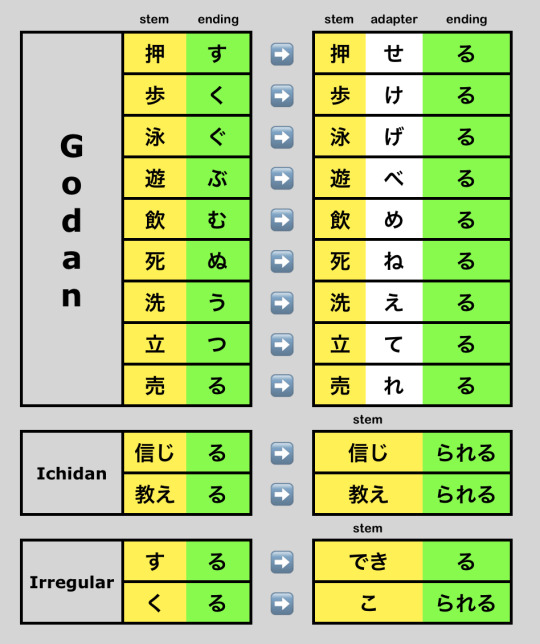
There are 2 things to notice.
・する becomes a completely different verb, できる.
・くる changes its stem to こ and adds the -られる version of the ending.
By adding the potential form endings, something remarkable happens. All of the new verbs we form will be Ichidan verbs!
From there, in place of the final -る we have 6 other endings that we can attach to make new verb forms. They are:
ない - not able to do たい - wants to be able to do ます - can do (polite) れば - if able to do… た - was able to do / successfully did て - able to do, and then/so …
Here are some examples with the Godan verb 歌う:
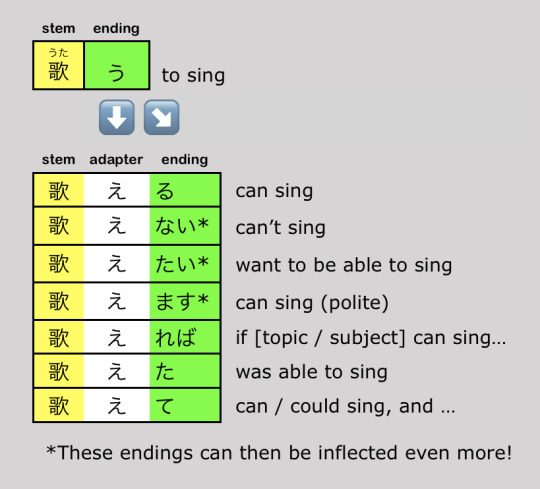
Incredibly, you can end up with 24 endings - just from the potential form alone (歌えなかった、歌えたくない、歌えました etc.). The possibilities and the flexibility are enough to make your head spin.
【ら Removal】
Before we move on to the next ending family, we should talk about this. For Ichidan verbs, there is a phenomenon known as ら Removal that you may encounter. In order to say these verbs easier and slightly quicker, some people remove the ら from the potential form*. This would result in saying 信じれる or 教えれる instead of the longer forms. Feel free to do this when you speak / write, but keep in mind that it is informal.
【The Receptive Form Endings】
Next let’s look at the receptive endings. This is used when you want to express that something was done to someone or something. In English it is very similar to the passive voice SOMETIMES, but it is not exactly the same.
For Ichidan verbs, it appears as -られる. For Godan verbs, it needs the あ sound adapters and appears as -れる. Here are your examples:

Just like with the potential ending, the る final character can be replaced by 6 other endings.
ない - does not receive the action of the verb たい - wants to receive the action of the verb ます - receives the action of the verb (polite) れば - if [topic / subject] receives the action of the verb, then… た - received the action of the verb て - receives / received the action of the verb, and (then)…
This might be the hardest set to understand so let’s see some examples, this time with the Ichidan verb 建てる.
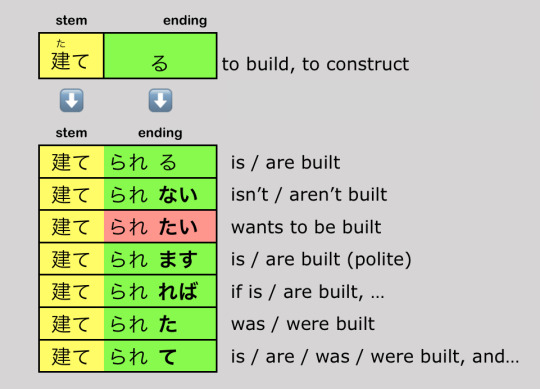
Because buildings, roads, etc. don’t have desires, 建てられたい doesn’t make sense. However, the -られたい / -れたい ending can make sense with other verbs.
【Confusing -られる and -られる】
For Godan verbs (and する and くる) the potential endings and the receptive endings are different.
The verb 選ぶ (えらぶ) means “to choose”. Its potential form is 選べる while its receptive form is 選ばれる. No problem.
However for Ichidan verbs, there might be a mixup.
The verb 教える (おしえる) means “to teach”. Its potential form AND its receptive form are both 教えられる!How do we distinguish them?
The answer is context. If you’re lucky, the writer / speaker will use ら removal (only possible for the potential form) and then you’ll be able to see / hear the difference. Other than that it’s really up to context.
The good news is that the choice of topic, subject and particles will most times make it perfectly clear which form is being used. For the remaining times, it will be best just to ask!
At least now you are aware of the possibility for confusion. That is a great start.
【The Causative Form Endings】
Lastly let’s look at the causative endings. These endings are used when you want to say that someone either made or let another person do something. (Imagine a mother making a child do homework vs letting a child play games.)
For Ichidan verbs it appears as させる. For Godan verbs, it needs the あ sound adapters and appears as せる. Here are your examples:

By now you know the deal 😂 Here are the 6 other endings:
ない - does not make / let someone 〜 たい - wants to make / let someone 〜 ます - makes / let’s someone 〜 (polite) れば - if made to / allowed to 〜, then… た - made / let someone 〜 て - makes /made / lets/ let someone 〜, and (then)…
Now let’s look at some examples with the Godan verb 言う:
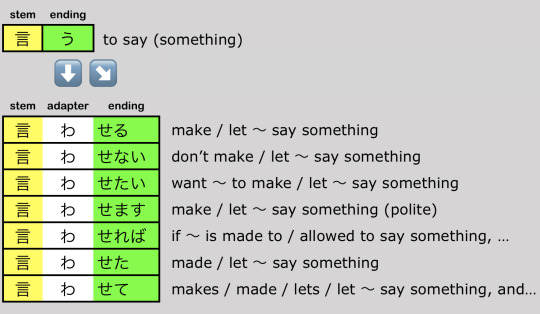
The particles used in causative sentences will tell you which meaning is being used. It all comes down to whether there is willful action taking place or not.
【Conclusion】
Whew, that was a LOT of endings! If you just take one verb and think of all the different things you can now say, you’d be amazed. On top of that, think of how many verbs you know by now. It truly is breathtaking. 👏🏾 Here is a summary of this and the previous post:
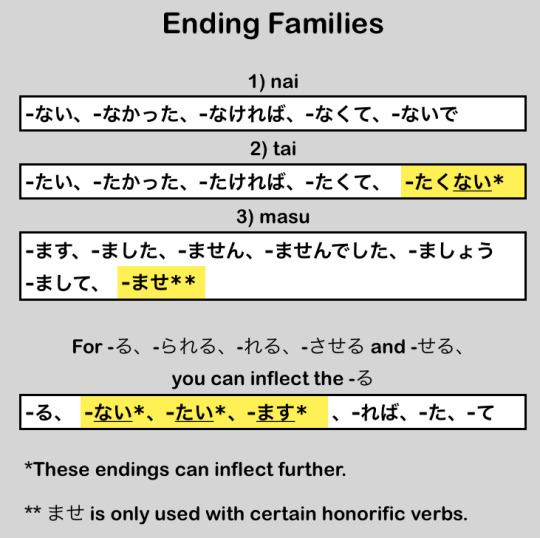
I hope you let all this information percolate and then come back and reread this and the last post. I also have a post about the basics of receptive and causative sentences here. It will take a while to absorb everything, but once you do, you’ll be unstoppable! If you have any questions feel free to ask, and I’ll see you next post!
Rice & Peace
– AL (アル)
👋🏾
*There is only ら removal with potential form verbs. Receptive forms are left as is. Also, it depends on which region of Japan you are in.
#japanese verbs#japanese language#japanese#learning japanese#japanese lesson#learn japanese#日本語の勉強#日本語#日本語勉強#langblr#japanese studyblr#japanese study#studyblr#studying japanese#language studyblr#language#language study#languages#にほんご
16 notes
·
View notes
Text
Small つ (Soku-on)
In the last post, we talked about how we can lengthen the 5 vowel sounds of Japanese. In this post, it’s time to look at what we can do to the consonant sounds. Let’s get into it!
What Does っ Do?
The small version of つ is called a soku-on, ちいさい 「っ」 , or just small つ. Here is a side-by-side comparison:
つ and っ
Putting the small つ in front of a consonant will double that consonant. To pronounce a doubled consonant, you very briefly stop the airflow in the space between your vocal cords. This space is called the glottis, and so the sound is called a glottal stop. Most of the time, small つ tells you to make a glottal stop.
Now, you might think that with the exception of あ、い、う、え、and お, you can use soku-on to double any other hiragana character… Luckily for you, that’s not how it works!
As it turns out, small つ can only come before characters in the K, S, T and P sound groups.
The K Sound Group

For these 8 situations, the soku-on simply tells you to make a glottal stop. The same characters with a soku-on and without a soku-on will make completely different words. Here are some examples:
みか is a woman’s name but みっか means “three days” or “the third day of a month”.
ゆっくり means “at your own pace” but ゆくり is not a word.
The S Sound Group

These 8 situations are pronounced a little differently. They are made not with a glottal stop, but by elongating the “s” sound.
いっしょ means “together” but いしょ means “a will” or “a note left by someone who has died”
The name of this blog is いっしょにほんご when you write it in Hiragana.
The T Sound Group

These 8 characters with a soku-on are pronounced with a glottal stop.
The super popular digital Tamagotchi pets are an example of using そくおん. You would spell it as たまごっち in Hiragana.
くっつく means “to stick together” but くつく is not a word.
The P Sound Group

Finally we have the regular P Sound Group.
いっぱい = one cup / bowl of something しっぱい = failure, mistake, blunder しゅっぱつ = departure, leaving やっぱり = as expected, it makes sense (that) りっぱ = splendidness, being fine, handsomeness いっぽう = one way (out of two) いっぽん = one long cylindrical thing にっぽん = a more formal way of saying Japan
An Ending っ
Sometimes you will see small つ at the end of a word or a sentence. This is just a way for the speaker or writer to express emotions (usually anger, surprise, or sadness). You may see small つ used together with long vowel sounds like below:

Just keep in mind that these are all basically pronounced the same so the difference is mainly when reading them. Because you have the ability to use / mix and match long vowel sounds, ちょうおんぷ and the small つ, it gives you a lot more flexibility to express emotions through text.
The Character Before っ
Let’s take a look at the word がっこう. It means “school”. We’ve been focusing on the small つ and the character after it.
っこ ➡️ kko
But now I’d like to focus on the small つ and the character before it.
がっ
We will deep-dive into this in the Kanji section, but it turns out that many times, the small つ actually means that there was a sound change!
For がっこう, there is actually a “hidden character” (く) under the small つ!Crazy stuff!

Just for your own curiosity, when you learn new words with the small つ, look them up in a dictionary and see how many times there is a hidden character under the small つ. It’s not 100% of the time, but you might be surprised at how often it happens.
Conclusion
And there you have it! The soku-on or small つ can completely change the meaning and the pronunciation of words. In my experience, getting used to hearing and pronouncing words with small つ was easier than words with long vowels. But with time, you’ll get the hang of both concepts. Good luck!
Rice & Peace,
– AL (アル)
👋🏾
#hiragana#learn hiragana#isshonihongo#japanese#language studyblr#language blr#study blr#にほんご#日本語の勉強#日本語#日本語勉強#japanese language#langblr#learn japanese#learning japanese
26 notes
·
View notes
Text
Long Vowel Sounds
Chō-on is the extending of Japanese vowel sounds. This may not seem like a big difference when it comes to English but it is huge in Japanese. Even in English, think of the reaction to saying “I went to.” vs “I went too.” In Japanese the difference is even bigger!
Since there are only 5 vowel sounds in Japanese, there can only be 5 long vowel sounds. Let’s get into it!
Syllables vs Morae
When it comes to English words, there are several ways in which we can break them down. You can talk about how many letters a word has. In terms of sounds, you can talk about syllables and you can talk about how many sounds a word is made up of.
Take the word “teacher” for example:
letters ➡️ t-e-a-c-h-e-r (7) sounds ➡️ t-ea-ch-er (4) syllables ➡️ teach-er (2)
Japanese is very different. It doesn’t actually make sense to talk about syllables because there are words that are one syllable length but that have different speech times. A mora solves this problem. 1 mora represents one unit of sound length. A Japanese word can be 1 syllable but 2 or 3 morae long.
Tokyo written in English vs written in Hiragana is a good example:
letters ➡️ T-o-k-y-o (5) syllables ➡️ To-kyo (2) Hiragana characters ➡️ と-う-き-ょ-う (5) morae ➡️ と-う-きょ-う (4)
You can see that each syllable of Tokyo is actually made up of 2 morae each. To better represent this, it would be better to write it as Tōkyō. We will see that it has two extended vowel sounds.
The Extended あ Sound
The first sound is an extended あ sound, similar to “aah” in English. There are 2 different ways that you will see this sound written:
① 【あ VSG character + あ】 for example おかあさん = mother
② 【ゃ Sound Group character + あ】 for example じゃあ = alright, well…, so then…
Pronouncing あ should take half as long as pronouncing かあ. Therefore あ is considered 1 mora long while かあ is considered as 2.
The first spelling of this sound is fairly rare, while the second spelling is usually used in words that express sounds and feelings at the end or beginning of sentences.
The Extended い Sound
The next sound is the extended い sound. It’s the same as when you draw out the “ee” sound in “see”. There is only 1 way you will see this written:
① 【い VSG character + い】 for example やさしい = simple, easy, kind
There are lots and lots of adjectives that end with しい. A large majority of them express feelings.
The Extended う Sound
The next long vowel sound is the extended う sound. This sounds like the end part of the sound cows make - mooo! There are two ways this sound can be written:
① 【う VSG character + う】 for example くうき = air
② 【ゅ Sound Group character + う】 for example しゅうでん = the last train (of the night)
The Extended え Sound
This sound is similar to how we pronounce the letter “A” in English. It has two spellings:
① 【え VSG character + え】 for example おねえさん = older sister
② 【え VSG character + い】 for example せんせい = teacher, master
Of the two, you will hardly ever see the first spelling. The second one is much more common.
The Extended お Sound
The last vowel sound is a drawn-out way of pronouncing the English letter “O”. This sound has 3 ways it can be written:
① 【お VSG character + お】 for example とおい = far
② 【お VSG character + う】 for example ほんとう = real
③ 【ょ Sound Group character + う】 for example きょう = today
The first spelling of this sound is used the least often. You will see the last two spellings much more often.
The Importance of Chō-on
Distinguishing between long vowel sounds and regular vowel sounds is SUPER important in Japanese. Beginners of Japanese might see “Tokyo” written in English and think that it’s written as ときょ in Hiragana. That is completely incorrect.
Another example is しょこく as compared to しょうこく. Said with a short vowel sound (しょ) it means “various countries”. However, if you use a long vowel sound (しょう) the meaning changes to “small countries”. Luckily this is not such a huge mistake, but sometimes you might be saying something completely different than what you think you’re saying!
5 More ようおん and ちょうおんぷ
We’ve already talked about ょ、ゅ and ょ. It turns out that there are also small versions of あ、い、う、え、and お. These are sometimes used in place of the conventional way of spelling the long vowel sounds.
なあ can also be written as なぁ.
There is just one wrinkle. While な is 1 mora (1 unit of sound length) and なあ is 2 morae, なぁ is ambiguous. In some cases it may be 2 morae but in other cases it could be 1.5 morae. Unfortunately it’s going to depend on the context and the speaker. For comparison, here are all the ようおん and their regular counterparts:
あいうえおやゆよ and ぁぃぅぇぉぅゃゅょ
Yet another way that you can write long vowel sounds is with a chō-onpu. This means “ちょうおん mark / sign” and is a long dash that is mostly used to show long vowel sounds in Katakana words. In rare situations though, it is used with Hiragana, as in the word らーめん.
This means that for the long vowel sound in ramen, you technically have three ways that it could be written!
らあめん らぁめん らーめん
Of those three, the last one is used the most often. Also be aware that when Japanese is written vertically, the ちょうおんぷ will also appear vertically.

NOT Chō-on
Finally, I think it’s important to talk about what are not long vowel sounds. The word おかあさん has that long vowel sound in the middle but take a look at this next word:
あかあか
This word does not have a long vowel sound in the middle! Why??
For the answer, we need to see these words written in Kanji!

A long vowel sound won’t fall in the middle of two Kanji characters. It is possible though, that two Kanji characters can make a long vowel sound together, as shown below:

This is just one of many reasons that studying Kanji becomes more and more important as you learn more Japanese. There are times when seeing Hiragana alone might lead you down the wrong pronunciation path!
Conclusion
And there you have it - a deep dive into long vowels of Japanese! It definitely takes training for your ears to hear the subtle difference between short and long vowel sounds. I get tripped up sometimes even now 10 years later. All you can really do is laugh it off and make a mental note to look into it later. This is the journey of a Japanese learner!
Rice & Peace,
– AL (アル)
👋🏾
#learn hiragana#hiragana#japanese#日本語#japanese studyblr#japanese language#learn japanese#日本語の勉強#language#language studyblr#にほんご#japanese vocab#japanese vocabulary#japanese study#japanese lesson#learning japanese#language blr#study blr
13 notes
·
View notes
Text
Pair Characters (Yō-on)
Hello and welcome back 😊
I have good news for you! With the 71 Hiragana characters you’ve learned, there are no other new character shapes that you need to learn!
However, there are 3 more groups of sounds that will be represented by character pairs. Let’s look at what sounds they make and how they are written.
Small (Yō-on) Characters
In our last post, we talked about Vowel Sound Groups. In this post we will need 12 characters from the い VSG:

Disregarding the い, we will be adding a small version of the Y Sound Group to each character. These miniature versions are called Yō-on, which means “contracted” or “distorted” sounds. For comparison, here are the Y Sound Group characters and the Yō-on characters side-by-side:
やゆよ、ゃゅょ
By the way, on a keyboard if you want to type those small Hiragana characters, you type the letter “x” followed by one of the three characters. (Type “xya” to get ゃ, etc.).*
The ゃ Sound Group

As you can see, adding the ゃ character to each of the 12 sounds in the い VSG results in the や Sound Group. With the exception of しゃ, ちゃ, じゃ and ぢゃ, all of those characters have “ya” in their pronunciations.
In modern Japanese, (especially in the Tokyo area) if you hear the sound “ja” you can be fairly sure that it will be written as じゃ. ぢゃ is rarely if ever used.
The ゅ Sound Group

The next group of sounds are formed by adding the ゅ character. Again, you will probably never see the sound of “ju” represented by ぢゃ. You will see it as じゅ.
The ょ Sound Group

Finally, we have the sounds formed by adding the ょ character. Just like with ぢゃ and ぢゅ, if you hear the sound “jo” it will almost always be represented by じょ instead of ぢょ.
Different Sounds and Words
An important point to highlight is that ゃ,ゅ and ょ make completely different sounds than や,ゆ and よ. Technically ゃ,ゅ and ょ don’t make any sound by themselves. The sound is completely dependent on the (regular) character that they are paired with.
This means that しゃ is a VERY different sound compared to しや. You have to be careful because you might be saying a completely different word.
しや = field of vision, one’s outlook しゃ = 1) company, 2) vehicle, 3) hut
If written in Kanji, しや is one word with 2 Kanji characters. However, しゃ can be written in many ways, and each different meaning has a different single-Kanji representation. Seeing and associating words with Kanji will help you to separate them in your head.
The ”NY” Problem
Now, as a native New Yorker, I have to say that this section is not about a problem with New York! This is actually a problem with writing words in Romaji. Look at these 4 Japanese words:
konya, honyaku, onyomi, kunyomi
Let’s take those first 2 words, konya and honyaku. konya means “this evening” or “tonight”. Honyaku means “the Japanese translation of a word.” The problem though, is that “nya” combination of letters. If we were to write those words in Hiragana, should it be “にゃ” or “んや”??

In order to get around this problem, we need to use an apostrophe to indicate whether you need 1 or 2 Hiragana characters. If there is an apostrophe after the “n”, it means you need the ん character. If there is no apostrophe, you will have either the にゃ、にゅ or にょ characters.**
Of course, as your Japanese improves, you’ll see those words written in Kanji. Through studying Kanji, you’ll get a much better sense of how Japanese words are separated.
Conclusion
There you have it! Now you’re one step closer to mastering Hiragana! There’s no shortage of reading and writing practice for Hiragana out there. Have fun and take pride in the fact that you’ve made it this far.
Next post we’ll look at long vowel sounds. Until then I’ll leave you with the full version of my handy Hiragana chart! Practice until you know every character without needing Romaji. Good luck!

Rice & Peace,
– AL (アル)
👋🏾
*There are 5 more small versions of Hiragana characters that can be written. We will see them in the next post.
**The correct way to write those 4 words is: kon’ya, hon’yaku, on’yomi, and kun’yomi. We’ll talk about on’yomi and kun’yomi in the Kanji section. A word like nyojitsu (meaning reality, or real conditions) has no apostrophe, and so would be written as にょじつ.
#learn hiragana#hiragana#isshonihongo#japanese language#japanese#studying japanese#japanese study#studyblr#language studyblr#language study#日本語#japanese studyblr#learn japanese#日本語の勉強#にほんご#japanese lesson#japanese langblr#japaneselessons#learning japanese#language blr#study blr
13 notes
·
View notes
Text
Vowel Sound Groups
So far we’ve talked about 15 Hiragana sound groups and 71 characters in all! Here is a chart that you can use to review what you’ve learned:

If you look at that handy chart, you’ll notice that I went horizontally from right to left when I introduced each character.
However, in this post we’re going to switch it up. Let’s talk about what we see if we read that chart vertically instead of horizontally.
The あ Vowel Sound Group

The first group all end in the あ vowel sound. Some of these sounds will be very important when we talk about negation in verbs. They will also be important when we talk about receptive and causative sentences.
The い Vowel Sound Group

The next VSG will be very important when we talk about our last set of 36 Japanese sounds. They will also be important when using the polite forms of verbs and when you want to say that you want to do an action.
Keep in mind that ぢ is rarely used in modern Japanese words.
The う Vowel Sound Group

9 of the sounds in this group will be very important when we talk about Japanese verbs.
Just like ぢ, づ is not often used in modern Japanese words.
The え Vowel Sound Group

This group will be important when we talk about how you say you are able to do something, and also when you want to say ”if I do X, then Y”.
The お Vowel Sound Group

This final group is used when you want to say “let’s do 〜” and also when you talk to yourself about doing an action.
Conclusion
Grouping the characters by their ending vowel sounds will become very useful later on as we get into the grammar of Japanese. For now, it can be a useful way of reviewing and remembering the characters you’ve already learned. See you next post!
Rice & Peace,
– AL (アル)
👋🏾
#learn hiragana#hiragana#isshonihongo#japanese language#learning japanese#learn japanese#日本語の勉強#日本語#日本語勉強#japanese studyblr#langblr#japanese study#studyblr#studying japanese#japanese#language studyblr#にほんご#language study#japanese lesson#japanese langblr#japaneselessons#language blr#study blr
8 notes
·
View notes
Text
Five More Sound Groups
After you learn the basic 46 Hiragana characters, the next set belong to 5 different sound groups.
First, there are 20 characters that change their pronunciation by adding a small mark to them. The mark looks like a quotation mark and is called a dakuten.
1) The G Sound Group
These sounds are completely regular. Just combine the “g” sound with the 5 vowel sounds of Japanese - あ、い、う、え and お.

Here is a practice game for the G Sound Group.
2) The Z Sound Group
For these 5 sounds, there is only 1 irregular pronunciation. Instead of “zi” the already-irregular し becomes “ji”. Other than that, you just combine the “z” sound with the あ、う、え and お sounds.

Here is a practice game for the Z Sound Group.
3) The D Sound Group
In this sound group, the already-irregular ち and つ become “ji” and “zu”. Other than that we have the “d” sound combined with the あ、え and お sounds.
Notice that instead of “di”, the ぢ character is pronounced as “ji” and instead of “dsu” the づ is pronounced as “zu”. They are pronounced exactly the same as じ and ず in most parts of Japan, though historically, they had different pronunciations. See what Wikipedia has to say about these characters.

Here is a practice game for the D Sound Group.
4) The B Sound Group
Good news! This group is completely regular. Just combine the “b” sound with あ、い、う、え and お.

Here is a practice game for the B Sound Group.
5) The P Sound Group
For these last 5 characters, things are slightly different. Instead of a dakuten mark, these characters have what looks like the degree symbol next to them. This mark is called a han-dakuten. These characters are just the “p” sound combined with あ、い、う、え and お.

Here is a practice game for the P Sound Group.
Sorting the Characters
Lastly, we should talk about character order. How would you look up these characters in a dictionary or on a website? There are 3 different ways that you might find them sorted.
The first possibility is that these 25 characters will be separated from the basic 46 Hiragana characters. That is what I’ve done here. However, this is very rare. For Japanese-learners, this is a useful way to sort the characters, but you won’t really find this grouping out in the wild very often.
Most of the time, these characters will not be separated on their own. That is to say, they will be grouped together with their regular Hiragana counterparts. (か and が will be together, as will き and ぎ and so on.) The question is, will the dakuten and han-dakuten characters appear after or mixed together with the regular characters?
In the following picture, there is no separation. Several areas of Tōkyō are listed. An area called ぎんざ (銀座) is listed in the か row. There is no separate が row. Notice that it comes before an area called きば (木場).

On the other hand, the main dictionary that I use sorts words in a different way. This time, there is a kind of separation.
The か section still contains words that start with が, but they appear at the end. THEN it moves on to the き section. Here is a picture:

Conclusion
If you’d like an interesting mnemonic to remember these characters, here you go:
Giant Zebras Dance Boldly in the Park!
Do with that what you will 😂
Congrats, you now know a whopping 71 Hiragana characters! There are only a few more left before you know every character. You’re almost there! See you next post.
Rice & Peace,
– AL (アル)
👋🏾
#hiragana#learn hiragana#isshonihongo#learning japanese#learn japanese#日本語の勉強#日本語#日本語勉強#japanese language#japanese studyblr#langblr#japanese#japanese langblr#japanese lesson#language studyblr#にほんご#japanese study#language study#studying japanese#japaneselessons#language blr#studyblr#study blr#learnjapanese
14 notes
·
View notes
Text
The Basic 46
This may be your very first page on your road to learning Hiragana! Either way, welcome!
There are 46 basic Hiragana characters. 6 of them are represented by a single English letter, while 3 of them are represented by three letters. The remaining 37 are all represented by two characters.
【Romaji】
First let’s talk about Romaji. You may have heard that Japanese has 3 sets of characters to express the language – Hiragana, Katakana, and Kanji. While that is true, there is a fourth set of characters and that is Romaji!
If you see the word “sake” you automatically read it as a word that rhymes with “take” and means “for the benefit of someone or something”. However, this is the English reading of the word. If you look at that word as Romaji, it is pronounced as “sah-keh” and it means Japanese alcohol.
Romaji is not English. It is an attempt at writing Japanese words with the English alphabet. There are sounds in each language that are not in the other, so relying on Romaji for too long is not a good idea. It is really only useful when you are beginning to learn Hiragana (and maybe 1 or 2 instances after that).
【Order】
Just like how we have something called “alphabetical order”, there is also an order to Hiragana (and katakana as well). To remember the order, there are several mnemonics that people use but the one I’ve always used is:
Kana Signs, Think Now How Many You Really Want
Keep in mind that these are only for the consonant sounds. And with that, now let’s look at those 46 characters!
【The Vowel Group (あいうえお)】
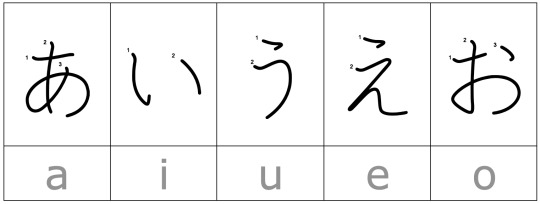
These 5 characters are the vowels of Japanese. While English (depending on where you are from) can have anywhere from 24 to 27 different vowel sounds, the GOOD NEWS is that Japanese only has these 5!
【The K Sound Group (かきくけこ)】
At this point we need to be aware of a big difference between Japanese and English. If I asked you to break down the sounds of the word “kid”, you would tell me the 3 individual sounds for each letter. But in Japanese, the ”k” and “i” sounds MUST go together. The majority of Japanese hiragana characters are made up of a consonant-vowel pair.
This is why almost all of our remaining hiragana characters need either two or three English letters. The K Sound Group 2 is simply the consonant “k” sound and each of the 5 vowel sounds.

【The S Sound Group (さしすせそ)】
Our next group is made up of the consonant “s” sound and each of the 5 vowel sounds. However, in this group we have our first irregular character!
According to the pattern so far, you would think that the し character would be pronounced “si”, as in the Spanish word for “yes”. In actuality, it’s pronounced “shi” like the English word “she”. This is something to take a mental note of.

【The T Sound Group (たちつてと)】
The next group is mostly made up of consonant “t” sound and each of the 5 vowel sounds. This time, we have two irregular characters! Instead of sounding like the English word “tea”, the character ち sounds like the second syllable of the English word “catchy”.
Unfortunately, the character つ doesn’t have any equivalent sound in English. Instead of sounding like the Spanish word for you (tu), the closest we can get is trying to make the “t” sound while saying the name “Sue”! This character took me a bit of practice and a lot of time to master.

【The N Sound Group (なにぬねの)】
Good news: The next group doesn’t have any irregular characters, so it is pretty straightforward!
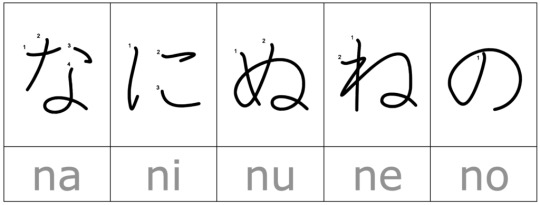
【The H Sound Group (はひふへほ)】
The H Sound Group has one irregular character. You might be tempted to think that ふ is pronounced as “hu”. If you look at the English representation, you might think that it’s pronounced as the first part of the word “fool”. In actuality it is pronounced somewhere in between! Just like つ, this character took me some time to get right.
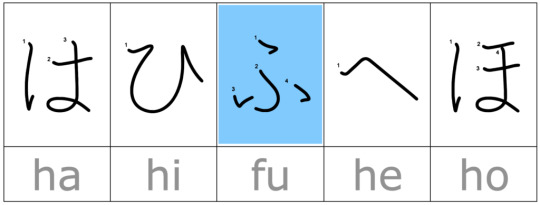
【The M Sound Group (まみむめも)】
This group is also pretty straightforward. No irregular pronunciations here!
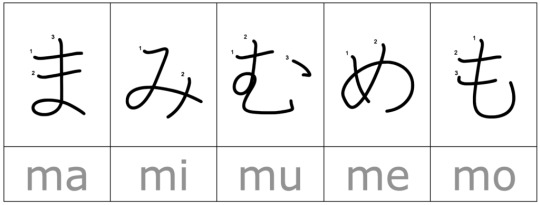
【The Y Sound Group (やゆよ)】
You’ll notice that this group only has three characters. There used to be characters for the sounds “yi” and “ye” but they dropped out of modern use.
Also, these 3 characters are very important for making another set of sounds. We’ll get into that in a later post.

【The R Sound Group (らりるれろ)】
This group appears to be simply the 5 vowel sounds added to the consonant “r” sound, however it isn’t that simple.
As you may or may not know, Japanese people have a very hard time pronouncing and differentiating between the English “r” and “l” sound. The reason is that they don’t have those sounds in Japanese. Unfortunately that also means that these 5 characters are not easy for native English speakers to pronounce. Each character’s pronunciation is actually somewhere between an “r” and an “l” sound. These characters took me the longest time to master (especially in long words!)
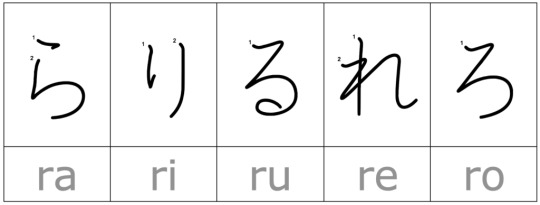
【The W Sound Group (わを)】
This group only has 2 characters. The thing of note here is that を sounds almost identical to the character お. を is only used as a particle, so it will never appear in the middle of a word. Also, when it’s used as a particle, you might be able to hear a slight pause after it. These kinds of tricks make it easy to figure out when you are hearing を and when you are hearing お.
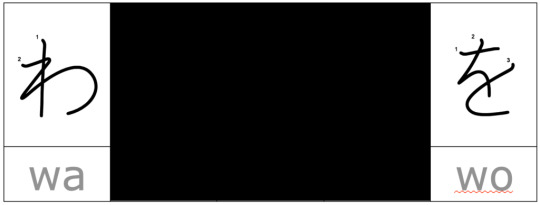
【ん】
The last basic character is ん. This is actually the only character that can be represented by a single consonant. It is mostly easy to tell when you are hearing this character, but there will be times when its pronunciation changes. More on that later.

【Conclusion】
So there you have it! Some people say that you can learn all 46 characters in 2 days, others say it should only take a week. It took me longer than that and so I say, take your time! There is no race to learn them so go at your own pace. Make sure that you have a good time while you practice; you’ll be more likely to remember the characters that way. Hiragana are important for learning Kanji down the line so it’s best to do it right the first time. Good luck!

#learn hiragana#hiragana#japanese#日本語#japanese studyblr#japanese language#learn japanese#日本語の勉強#language studyblr#にほんご#isshonihongo#language blr#languages#studying japanese#japanese study#studyblr
38 notes
·
View notes
Text
IsshoNihongo! Hiragana Page
Hello everyone! Welcome to my page for the basics on Hiragana!
Hiragana are the gateway into Japanese. It all starts here. The posts below will help you get familiar with these basic Japanese characters. Enjoy!
① The Basic 46 (Sei-on) ② Five More Sound Groups (Daku-on & Han-daku-on) ③ Vowel Sound Groups (VSGs) ④ Pair Characters (Yō-on)
⑤ Long Vowel Sounds (Chō-on) ⑥ Small つ (Soku-on) ⑦ Pronouncing ん (Hatsu-on)
⑧ Furigana & Okurigana
For matching practice activities, click here.
#learn hiragana#hiragana#isshonihongo#learning japanese#learn japanese#日本語の勉強#日本語#日本語勉強#langblr#japanese studyblr#japanese language#language blr#study blr#language studyblr#language study
16 notes
·
View notes
Text
9.1) The Basics of the Receptive and Causative Forms
Hey everyone! In this post I’d like to go over some basics before we break down receptive and causative sentences.
Here is your vocabulary, short and simple:

【The Endings】
First, let’s look at the endings:

It’s time to reveal something about these endings. These are not just endings. In actuality they are helping verbs! THAT is the reason why the final -る can be inflected.

As a reminder, here is how we can inflect that final る:
-る ➡️ -ない、-たい、-ます、-れば、-た、-て
Notice that we attach those endings directly to the verb stems. Does that remind you of anything?? Yes, れる、せる、られる and させる are all Ichidan verbs!
On top of that, remember that -ない、-たい and -ます can further inflect (because they are ALSO helping verbs!) giving you lots and lots of possibilities. This info will come in handy a bit later.
【Receptive Sentences】
In the next post when we get to receptive sentences, there are 4 parts of each sentence that I want you to think about. Here is a visualization that will help:

As is always the case in Japanese, what comes at the end is super important so let’s “zoom in” and start by looking at the 2 end sections.
【The Internal and Received Actions】
Because れる / られる and ��る / される are actually verbs, it’s important to recognize that every receptive sentence actually contains 2 actions going on simultaneously. There is the action of “receiving” and there is an “internal action”. Let’s look at some examples:
① 褒められた
When you see this at the end of a receptive sentence, in your mind you can break this word down into two different actions - the action that was “received” and the “internal” action. The two parts are:
られた = received 褒め (to praise) is the internal action = was praised
In this case, once you figure out the actions, you only need to figure out who received the praising and who did the praising.
Here’s another example:
② 買われました
Let’s break down example 2:
れました = received (polite) 買わ (to buy) is the internal action = was bought (polite)
Because this is a Godan verb, the stem of the helping verb is れ. That won’t change. However the ending of the helping verb CAN change, and in this case it’s ました. Does it all make sense?
One more example:
③ 尊敬されたい
In this case, we have a する noun. No problem!
れたい = wants to receive 尊敬さ (to respect) is the internal action = wants to be respected
Now, is there anything you notice about those internal actions!?
For Ichidan verbs, する and 来る, the internal actions are just the verb stems! For Godan verbs, the internal action will always be the stem + its あ sound adapter.

The れる and られる verbs might have different endings too, but we already know the possibilities so it’s no problem. Now it should be much much easier to understand what is going on in all receptive sentences!
【Causative Sentences】
Causative sentences express the idea of either forcing or allowing an action to happen. These sentences basically have the same things going on as receptive sentences, except for the helping verbs at the end.

Whether the action was forced or allowed to happen, the end result is that the topic or subject “caused” the action. This is where the name causative comes from. Let’s look at some examples:
④ 食べさせた させた = forced or allowed to 食べ (to eat) is the internal action = allowed to / made to eat
When we get to the post on the causative form we will see how you know if it’s the “forced to” or the “allowed to” interpretation.
Here’s one more example:
⑤ アパートに入れさせなかった させなかった = didn’t force or allow to アパートに入れ (entering the apartment) is the internal action = was not let into the apartment
In example 5 it’s unlikely that someone was not forced to go into an apartment, so we go with the “not allowed to” interpretation.
【The Particles】
The particles in receptive and causative sentences will be very important. は、が、に、を and から will all be working together in harmony to express certain nuances. We’ll talk more about this in detail in the respective posts.
【Conclusion】
Well there you have it! Receptive and causative sentences were very hard for me to understand when I started studying Japanese. They still trip me up at times, but it helps to have this baseline of knowledge.
Now I believe that you are ready to look at full receptive and causative sentences. See you next post!
Rice & Peace,
– AL (アル)
👋🏾
#japanese verbs#japanese grammar#japanese receptive form#learning japanese#learn japanese#japanese studyblr#studyblr#japanese language#language#langblr#日本語の勉強#日本語#日本語勉強#にほんご#isshonihongo
38 notes
·
View notes
Text
#updated #I went through and cleaned up some things #enjoy!
4.1) Nouns and the Copula
Hello again everyone! 👋🏾 Welcome to another post to help you improve your Japanese!
Over the years, I have done a lot of thinking about Japanese and how the language works. When it comes to parts of speech I think that nouns are the most important one in Japanese. In this post let’s look at why they are so important and the power of nouns-copula pairs.
First, here is the vocabulary that will appear in this post:

【The Importance of Japanese Nouns】
We’ve talked about the 3 main sections of Japanese sentences. If you think about 2 out of those 3 (the topic section and the comment section) you may realize that nouns really do heavy lifting when it comes to communicating ideas.
How do we set up the topic section? Well, we take a noun (or a noun phrase) and attach the particle は to it. Now you or your listener / reader will know what the topic of the conversation is (for the time being). Without that noun part, you don’t have any topic.
Moving over to the comment section, we find that nouns are again very important. Much like the topic, the subject is made up of a noun (or noun phrase) and the particle が. Even though there are times when the subject is not stated, it’s always there - and it always involves a noun.
When you want to end the comment section of any given sentence, you can choose to use an adjective form or a verb form. If you don’t use either of those, your only other option is a noun-copula pair. It’s interesting to realize the several ways that nouns are important forming Japanese sentences.
【The Simplest Sentences】
Take a look at the following three Japanese sentences:
寒い! 食べましょう! 先生です!
These three sentences are perfectly understandable in Japanese society - despite being very short! The first sentence is an adjective and the second one is a verb form. The third one is an example of a noun-copula pair, and it shows that if you take a noun and attach a form of the copula to it, you are all set; with the right context, you will have a perfectly understandable sentence.
So let’s finally get to talking about whatever this copula is.
【What is a Copula??】
A copula is a verb that links or ties two things together. Think of it as a bridge that connects a noun with a description. In English our main copula is the verb “be”. Take a look at these two sentences:
I am a teacher. My friends are teachers.
“Am” is linking the subject (I) with the noun phrase “a teacher“. In the same way, “are” is linking the subject “my friends” with the noun “teachers”. “Am” and “are” in these sentences are two different forms of the same copula! In this case our copula is the “to be” verb, and the nuance of that copula is that the two sides are equal.
If we used a different copula, the meaning and / or nuance of the connection might change. If we used “became” for example, the two sides would still be equal BUT the nuance would change. The copula “became” adds the nuance that they were not always equal.

Japanese, on the other hand, only has 1 copula. Its positioning is also completely different. In Japanese, the noun-copula pair will always come at the end of the comment section*. First you set the topic and or the subject, then at the end, you finish with a noun-copula pair. No matter how many phrases you have in the middle, the noun-copula pair will always refer to (and describe) either the topic, the subject or both.

Japanese may only have one copula but there are many versions of this copula that all have their own nuances. In this post we’re going to take a look at 8 versions of the copula and how each of their nuances is slightly (or completely) different.
【The Polite Versions】
The first 3 versions of the copula are です、でした and でしょう. They are used for formal situations. This may be conversations with or writing for people you don’t know well. If you are talking or texting with someone you just met or someone like a co-worker or manager, you are most likely going to be using some of these 3 versions.
です is used when you want to say the [topic / subject] is / are / am + a description.
① トムです。 = is / am Tom.
The meaning will depend on the topic of the conversation. When someone you don’t know asks you what your name is, they will usually ask お名前は何ですか? Because they already set the topic to “your name”, example 1 is the most natural way to answer. there is no need to say 私の名前は first, because this would just be repetitive and unnecessary.
② 生徒でした。 = was a student / were students
でした is just the past tense of です. The nuance is that something used to be something else, but is no longer that description.
The last polite version of the copula we’ll be looking at is でしょう. This version has several nuances.
③ このセーター、【いい色でしょう】。 = this sweater, good color don’t you think? The color of this sweater looks good, right?
In example 3 you can imagine the speaker holding up a sweater that they recently bought and asking if it’s a good color. This version of the copula means that the speaker / writer believes that there is a connection between the topic / subject and the noun, and that he or she wants to confirm that connection. Notice that the Japanese sentence ends in a period, even though we would use a question mark in English.
④ 冗談でしょう! = It’s a joke / You’re joking, right?
Notice that this request for confirmation of a connection can translate to “don’t you think?” or “right?” in English. Unfortunately, there is one more way that でしょう is used.
⑤ 彼は明日は【暇でしょう】。 = as for him, tomorrow will be free = He will (probably) be free tomorrow.
In example 5, the speaker is more sure of the connection between the topic and the noun marked with でしょう. However, in Japanese culture it’s not good to speak in certainties so this version of でしょう can be translated as somewhere between “is / will be” and “probably is / will be”. It will depend on the speaker / writer’s level of confidence and how open they are with the listener / reader.
【The Plain Versions】
The next 3 versions of the copula are だ、だった and だろう.
だ is the plain version of です. Let’s say that you are very popular in your neighborhood in Japan. You walk into an Izakaya where the regular patrons haven’t seen you in a while. When you walk in, they might exclaim:
⑥ [your name] だ! = It’s you!
Whereas です would be too formal between friends, だ carries the nuance of closeness. We’ll talk more about だ a little later.
⑦ 生徒だった。 = was a student
Example 7 is just the plain version way to say example 2. Other than politeness level, だった and でした are the same.
だろう is basically used in the same way as でしょう, except for the politeness level.
⑧ このセーター、いい色だろう。
Example 8 is very similar to example 3. The meaning is exactly the same but with one key difference in nuance: だろう is more often used by men and boys than women and girls! It also comes off as feeling closer to だ sometimes. In written Japanese it carries the nuance of “I think” or “probably”. On the other hand, when spoken the nuance is stronger, more like “is” or “will be”.
【なら or ならば】
The next version of the copula that we’ll look at is なら(ば).
なら is used in conditional sentences. It carries the nuance of “if”.
⑨ 私が【あなたの立場なら】、… = I, your position if… = If I were in your position…
In written Japanese or if you want to make the conditional part sound a bit more formal, use ならば instead of なら. This is not really anything to think about too much though, because the end of the sentence is more important when it comes to politeness level.
Another thing to be mindful of, is that なら carries with it the implication that the listener / reader knows the context of what you are saying. In other words, sentences with なら(ば) usually come towards the middle or the end of conversation and not at the beginning.
【The Null Copula】
The final version of the copula is an interesting one. Let’s say that you and a friend are at a seafood restaurant in Ōsaka. You both are looking at the menu and your friend asks you what you two should order. You say “let’s go with edamame. How about you?” Your friend answers:
⑩ ぼくは、…かき ⬜︎ 。
Do you think your friend should use です or だ? ?
The answer is neither! です is too formal for a meal with a friend. BUT だ is too strong for this situation! Imagine if in English someone responded with IT’S OYSTERS! It would be very strange. In example 10, the most natural copula to use is none at all - or the null copula.
Technically, there does have to be a copula but by only saying the noun you have adjusted your speech to the appropriate amount of politeness, casualness and strength for the situation.
This will take some time to get right but I think that now you will notice that native speakers sometime leave out the copula when they are talking. This is the null copula.
【Conclusion】
So there you have it! All 8 versions of the Japanese copula.

As always I recommend reading native speakers’ Japanese sentences and looking for what you’ve learned from this post. Next try to listen to some natural conversations. Finally try to make your own sentences and see how they feel. Learning this language is a step-by-step process.
As always, feel free to ask me any questions! Thanks so much for reading and see you next time!
Rice & Peace,
– AL (アル)
👋🏾
* It is possible to have a noun-copula pair NOT at the end of the comment section, but somewhere in the middle. In these cases, the noun-copula pair actually marks the end of a clause. More on this in the next post!
144 notes
·
View notes